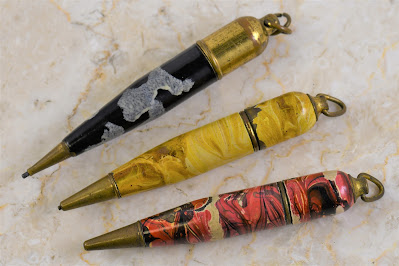This article has been included in The Leadhead's Pencil Blog Volume 7, now available here.
If you don't want the book but you enjoy the article, please consider supporting the Blog project here.
It’s a frustrating time, when so many of the things that have come my way were from bland online auctions, rather than amongst friends at pen shows. Sure, this is cool stuff I’m writing about, but I feel a little hollow every time I have to start an article with “look what I found during an online shopping session”:
I remember this came in a junk lot, but I don’t remember whether this was my target when I bid on it. As soon as I unwrapped it though, I did remember what I didn’t remember: I didn’t recall seeing an eagle pictured on the clip:
These Eagle pencils are enamel paint over brass, and they are usually found in pretty bad shape. This one is much better than average, with good plating on the trim and just a little bit of chipping around the clip mounting – very typical since that is where the metal is the most stressed from clipping the pencil into one’s pocket.
I’ve found a few of these over the years, in different colors and a couple different configurations:
The top three all sport the simple “Eagle” imprint and, as I recalled, I hadn’t seen one with an eagle pictured next to the name.
The lower three all have a different clip, marked “Eagle Pencil Co. USA,” running ‘left handed,” meaning that when you hold the pencil to write in your left hand, the lettering isn’t upside down.
Since long before I knew I should, I’ve kept these alongside some other enamel-over-brass pencils, which aren’t marked but share a lot of similarities:
I confirmed that these smaller pencils were Eagles belonging to the same series when I found an Eagle catalog from the early 1930s:
Both of these models are illustrated on page 75. The “graceful tapered” clip models are described as the Number 548 “Jot Sr.” - Number 1548 if painted in “the popular black and pearl finish.” The stubby golf pencils, also “popular . . . for its graceful tapered shape,” was the Number 547 “Jot” (with the black and pearl finish, Number 1547).
The Jot Sr. is shown with the left-handed version of the clip:
If you think this pencil looks a lot like a Sheaffer Balance, even if the finish is paint over metal rather than celluloid, Sheaffer apparently did, too. During Sheaffer’s patent infringement litigation with the Worth Company (see Volume 5, page 1), the Eagle Pencil Company was held up as a poster child on behalf of the defense for the notion that other companies were making streamlined writing instruments when Walter Sheaffer was still in diapers. The argument, however, was for naught. Sheaffer had firmly established its dominance in the world of round and pointy pens and pencils.
Then, with a win in its pocket, Sheaffer went after Eagle. Once a court has declared a patent valid, it is a tremendous hurdle in a second infringement action to challenge it – that’s likely the reason Sheaffer first targeted a smaller manufacturer that was less able to defend itself. The case was filed in Federal District Court in New York, and on December 3, 1931, the Court granted a preliminary injunction to Sheaffer preventing Eagle from offering pens and pencils that were pointy on the ends (the case citation is W.A. Sheaffer Co. v. Eagle Pencil Co., 55 F.2d 420 (S.D.N.Y. 1931)). The Eagle catalog must be for 1932, published shortly before the injunction was issued but modified before it was sent out:
Inside the front cover of the catalog, a notice has been added after the interior artwork was finished.
The notice specified that Eagle “modified the shapes of articles” on several pages of the catalog, starting with the page showing the most egregious challenge to Sheaffer’s Balance design patents:
And ending with the page which illustrates the Jot and Jot Sr. That likely explains the bottom example shown in my spread of Jot Sr. pencils:
The catalog notice also supports a statement I made in Volume 6 - that Eagle simply trimmed off the ends of this line of pencils:
In order to make them less pointy, to avoid any conflict with Sheaffer:
That theory is confirmed by this catalog, which includes the “New Eagle $1.00 Pencils” on page 72 – one of the pages illustrating pencils Eagle noted it had “modified”:
There were only two Eagle models on these pages which escaped “derounding” at the hand of the Sheaffer Balance: one was the model 522, because . . . well the Eagle “Perlux” was already flat on top:
The other, interestingly enough, is the short Jot. How did the Jot escape modification? It couldn’t have been because it doesn’t look enough like a Sheaffer, because it most certainly does:
Since Eagle was forced to modify a whole line of its products to be less Balance-like – except the one that resembled Sheaffer’s patented golf pencil shape – I’m wondering if there was this a compromise between Eagle and Sheaffer as to that one model, or if Sheaffer’s design patent for the golf pencil was invalidated.
Maybe.




















No comments:
Post a Comment